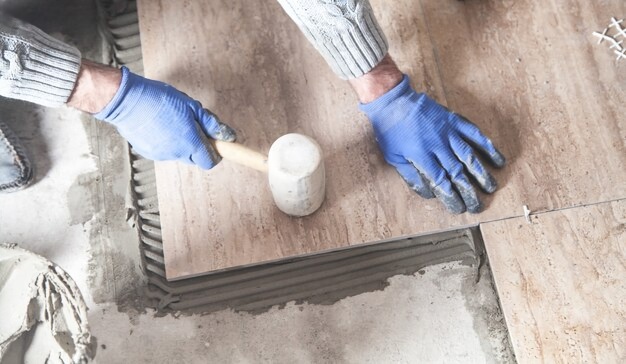
Tile Adhesive vs. Thinset Mortar: Understanding the Differences
When embarking on a tiling project, one of the critical decisions you’ll face is choosing between tile adhesive and thin-set mortar as your bonding agent. While both serve the purpose of adhering tiles to surfaces, they have distinct differences that can significantly impact the success and longevity of your installation. This comprehensive guide explores the characteristics, applications, pros and cons of tile adhesive and thin-set mortar, helping you make an informed choice for your specific project needs.
Composition and Formulation:
Tile Adhesive:
- Tile adhesive, or mastic, is a premixed organic adhesive that comes ready to use. It typically contains a combination of polymers, cement, and other additives to enhance bonding properties.
Thinset Mortar:
- Thinset mortar is a dry, powdered mix of Portland cement, sand, and additives. It requires adding water before use, allowing for a customizable consistency depending on the project requirements.
Tile Types and Applications:
Tile Adhesive:
- For smaller tiles and projects, tile adhesive is suitable for horizontal applications such as backsplashes and countertops. It’s not recommended for areas exposed to high moisture.
Thinset Mortar:
- Thinset mortar is versatile and suitable for various tile types, including ceramic, porcelain, and natural stone. It is preferred for larger tiles and vertical installations, making it ideal for floors, walls, and wet areas like bathrooms and kitchens.
Adhesion Strength and Flexibility:
Tile Adhesive:
- It offers good adhesion strength but may lack the flexibility required for tiles in areas prone to movement or temperature fluctuations.
Thinset Mortar:
- Thinset mortar provides a stronger bond and greater flexibility, making it suitable for areas where the substrate may shift, such as floors and walls, subject to vibrations.
Water Resistance:
Tile Adhesive:
- Generally less water-resistant, making it less suitable for wet areas like showers or outdoor applications.
Thinset Mortar:
- Thinset mortar, when properly mixed and applied, offers better water resistance, making it a preferred choice for areas exposed to moisture.
Setting Time:
Tile Adhesive:
- It tends to have a faster setting time, allowing for quicker project completion.
Thinset Mortar:
- Setting time can vary but is generally longer than tile adhesive. This extended curing time is advantageous for adjustments during tile placement.
Suitability for Specific Projects:
Tile Adhesive:
- Well-suited for smaller projects with standard-sized tiles and where a faster installation process is desired.
Thinset Mortar:
- They are preferred for larger tiles, heavy tiles, and areas with higher performance demands, such as floors and wet environments.
Cost Considerations:
Tile Adhesive:
- It can be more expensive per unit than thin-set mortar, but the ease of use may offset labor costs.
Thinset Mortar:
- Generally, it is more cost-effective per square foot, making it a preferred choice for larger projects.
Conclusion:
- In the tile adhesive vs thin-set mortar debate, understanding the nuances of each product is crucial for a successful tiling project. Consider the specific requirements of your installation, including tile type, project size, and environmental conditions, to make the right choice. Whether opting for the convenience of tile adhesive or the versatility of thin-set mortar, armed with this knowledge, you’ll be well-equipped to achieve a professional and durable tile installation tailored to your unique needs.







